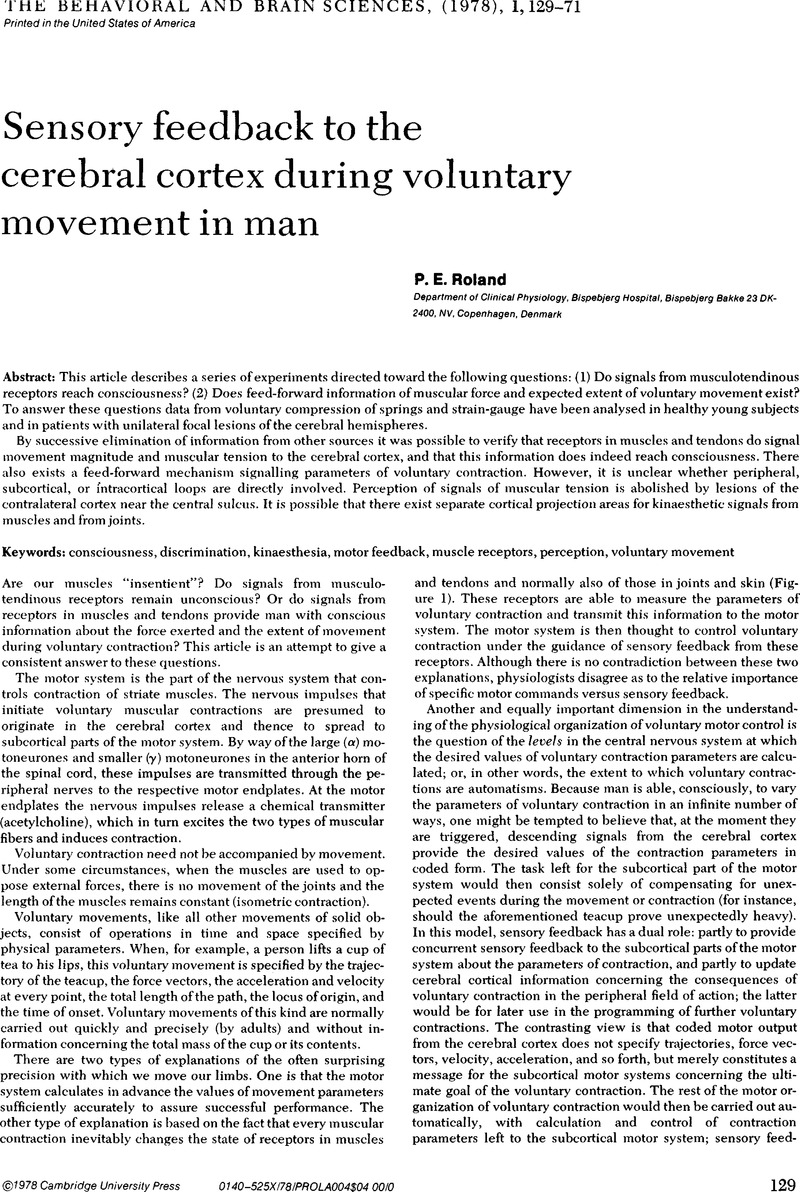Crossref Citations
This article has been cited by the following publications. This list is generated based on data provided by Crossref.
Jones, John Alfred
1981.
Preparing contingency plans for public speaking situations.
Communication Education,
Vol. 30,
Issue. 4,
p.
423.
Stein, R. B.
1982.
What muscle variable(s) does the nervous system control in limb movements?.
Behavioral and Brain Sciences,
Vol. 5,
Issue. 4,
p.
535.
Bawa, P. N. S.
and
Dickinson, J.
1982.
Force as the controlling muscle variable in limb movement.
Behavioral and Brain Sciences,
Vol. 5,
Issue. 4,
p.
543.
Inbar, Gideon F.
1982.
The role of proprioceptors and the adaptive control of limb movement.
Behavioral and Brain Sciences,
Vol. 5,
Issue. 4,
p.
551.
Hogan, Neville
1982.
Moving with control: Using control theory to understand motor behavior.
Behavioral and Brain Sciences,
Vol. 5,
Issue. 4,
p.
550.
Partridge, Lloyd D.
1982.
How was movement controlled before Newton?.
Behavioral and Brain Sciences,
Vol. 5,
Issue. 4,
p.
561.
Stark, Lawrence
1982.
Neurological ballistic movements: Sampled data or intermittent open-loop control.
Behavioral and Brain Sciences,
Vol. 5,
Issue. 4,
p.
564.
Stein, R. B.
1982.
Movement control views: From diversity to unity.
Behavioral and Brain Sciences,
Vol. 5,
Issue. 4,
p.
568.
Kelso, J. A. S.
and
Saltzman, E. L.
1982.
Motor control: Which themes do we orchestrate?.
Behavioral and Brain Sciences,
Vol. 5,
Issue. 4,
p.
554.
English, Arthur W.
1982.
Are whole muscles the fundamental substrate for the CNS control of movement?.
Behavioral and Brain Sciences,
Vol. 5,
Issue. 4,
p.
544.
Gottlieb, Gerald L.
and
Agarwal, Gyan C.
1982.
Control theoretic concepts and motor control.
Behavioral and Brain Sciences,
Vol. 5,
Issue. 4,
p.
546.
Pubols, Lillian M.
1982.
Control of limb movement without feedback from muscle afferents.
Behavioral and Brain Sciences,
Vol. 5,
Issue. 4,
p.
562.
Hoffer, J. A.
1982.
Central control and reflex regulation of mechanical impedance: The basis for a unified motor-control scheme.
Behavioral and Brain Sciences,
Vol. 5,
Issue. 4,
p.
548.
Mortimer, James A.
and
Eisenberg, Peter
1982.
How modest is the gain of the stretch reflex?.
Behavioral and Brain Sciences,
Vol. 5,
Issue. 4,
p.
557.
Pond, Caroline M.
1982.
The importance of connective tissue within and between muscles.
Behavioral and Brain Sciences,
Vol. 5,
Issue. 4,
p.
562.
Cruse, H.
1982.
Are position-control systems active during leg movement of walking arthropods?.
Behavioral and Brain Sciences,
Vol. 5,
Issue. 4,
p.
543.
MacKay, William A.
1982.
The motor system controls what it senses.
Behavioral and Brain Sciences,
Vol. 5,
Issue. 4,
p.
557.
Nichols, T. Richard
1982.
Reflex action in the context of motor control.
Behavioral and Brain Sciences,
Vol. 5,
Issue. 4,
p.
559.
Abbs, James H.
1982.
A speech-motor-system perspective on nervous-system-control variables.
Behavioral and Brain Sciences,
Vol. 5,
Issue. 4,
p.
541.
Harvey, Nigel
and
Greer, Kerry
1982.
Force and stiffness: Further considerations.
Behavioral and Brain Sciences,
Vol. 5,
Issue. 4,
p.
547.





